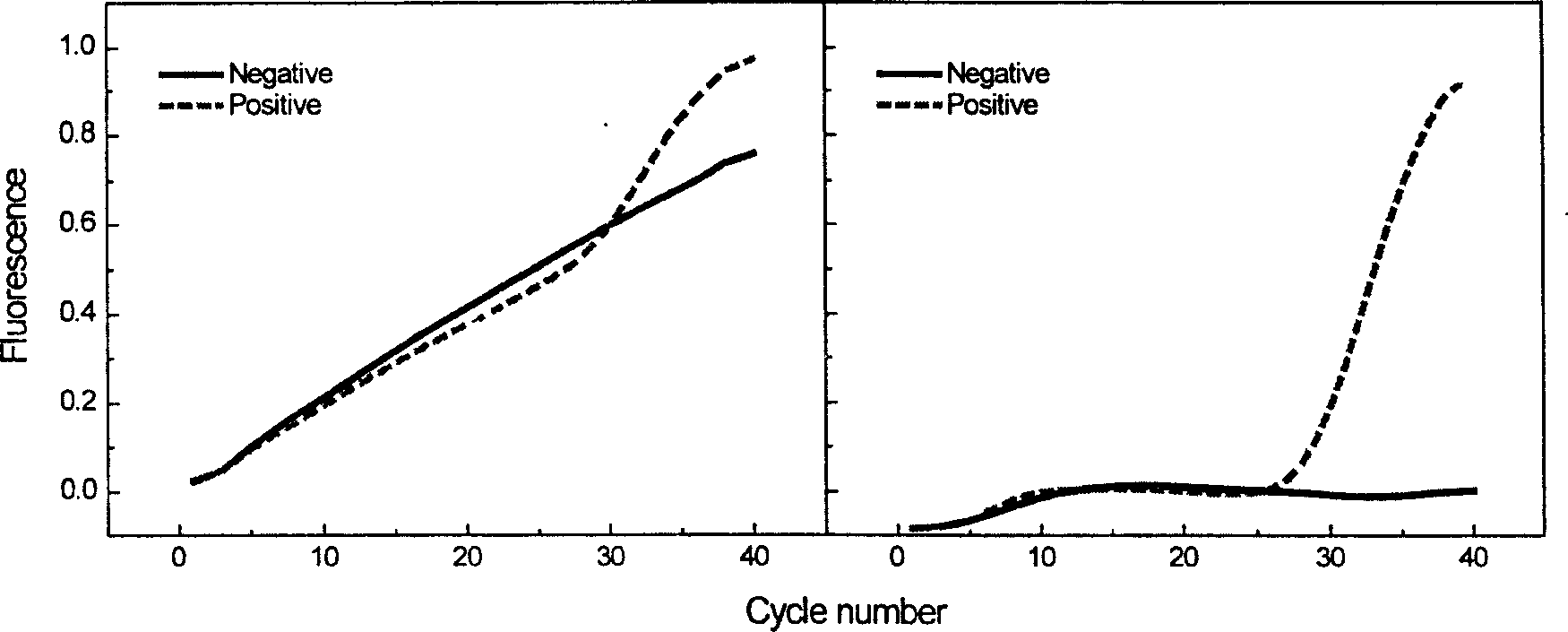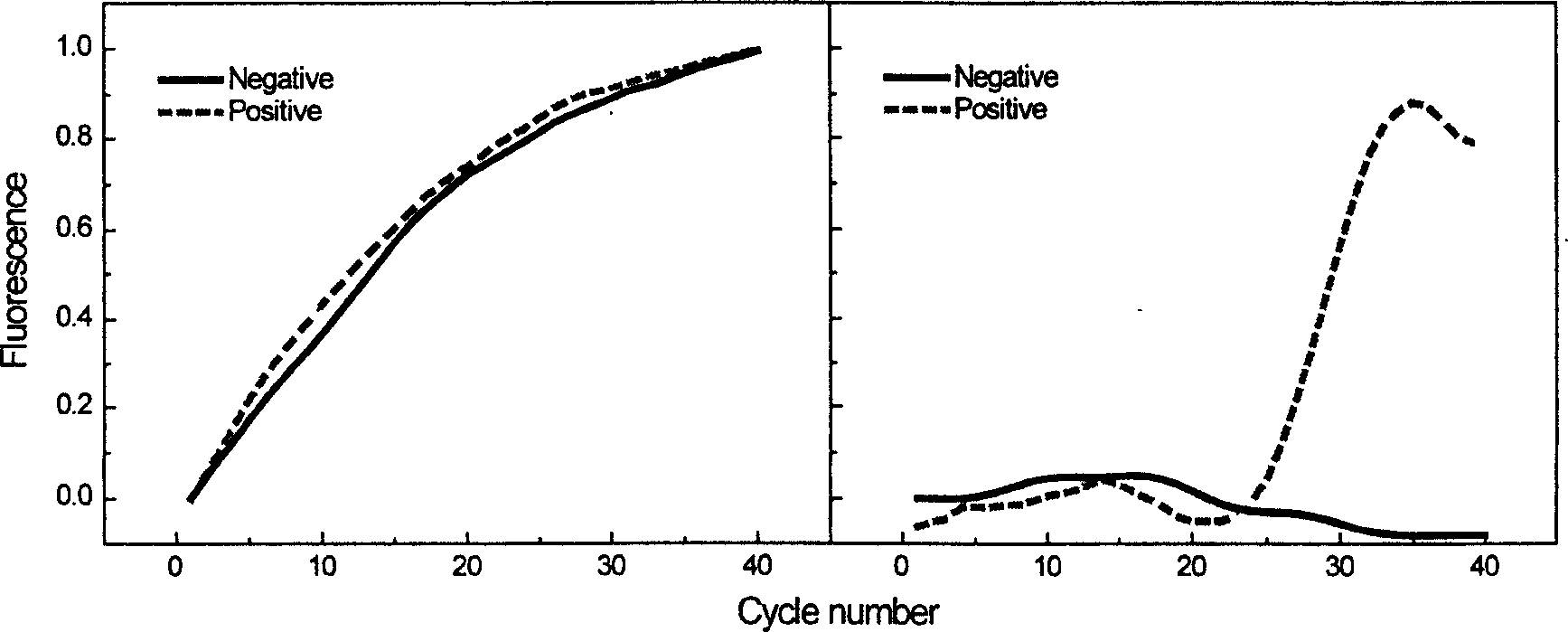Fluorescence probe for hgih temperature polyase exonuclease activity in real time PCR test
An exonuclease and fluorescent probe technology, applied in the field of fluorescent probes, can solve the problems of specific amplification signal interference and achieve the effect of improving performance
- Summary
- Abstract
- Description
- Claims
- Application Information
AI Technical Summary
Problems solved by technology
Method used
Image
Examples
Embodiment 1
[0036] Example 1: AmpliTaq Gold TM The amyloid precursor protein gene was amplified by DNA polymerase and detected in real time with an unmodified displacement probe and a positive-strand 5′ phosphorothioate-modified displacement probe.
[0037] The amyloid precursor protein (APP) gene is located on human chromosome 21. The abnormal expression of this gene is related to some diseases such as Down syndrome and Alzheimer's disease.
[0038] In this embodiment, the APP gene is the target gene, and primers and target-specific replacement probes are designed for real-time PCR detection. The primers used are Primer1 and Primer2, the length of the amplified product fragment is 100bp, and the probe used for detection is Probe1 or Probe2 (see the table for the sequence. 1, the same below).
[0039] 2.5μL of 10XPCR Gold buffer in 25μL reaction solution, 2.0mM MgCl 2 , 200 μM dNTPs, 1.0 U AmpliTaqGold TM DNA polymerase, 10 pmol upstream primer, 10 pmol downstream primer (see Table 1...
Embodiment 2
[0043] Example 2: pfuDNA polymerase amplifies the amyloid precursor protein gene, and detects in real time with unmodified displacement probes and phosphorothioate-modified displacement probes at the negative strand 3' end.
[0044] The target gene and primers in this example are the same as in Example 1, and the probe used for detection is Probe1 or Probe3.
[0045] 25μL reaction solution containing 10×Pfu reaction buffer (containing 20mM MgCl 2 ) 2.5 μL, 200 μM dNTP, 1.0 Upfu DNA polymerase, 10 pmol upstream primer, 10 pmol downstream primer, 10 pmol probe1 or probe3, 5 μL PCR product dilution template or ultrapure water (negative control). Reaction conditions: 95°C for 3 minutes, cycle period of 94°C for 15s, 55°C for 20s, 72°C for 20s, a total of 40 cycles, each time the fluorescence data of the FAM channel was collected in real time during annealing. MX 3000P real-time PCR instrument was used for detection.
[0046] For real-time PCR results, see figure 2 , the replacem...
Embodiment 3
[0047] Example 3: EX Taq DNA polymerase amplifies the amyloid precursor protein gene, using unmodified displacement probes, 5' and 3' phosphorothioate-modified displacement probes for long-fragment real-time PCR amplification detection.
[0048] In this example, the APP gene is the target gene, the primers Primer3 and Primer4 are used, and the length of the amplified product fragment is 1082 bp, and the probe used for detection is Probe1 or Probe4.
[0049] 2.5 μL of 10×EX Taq reaction buffer in 25 μL reaction solution, 2.0 mM MgCl 2 , 200 μM dNTP, 1.0 UEX Taq enzyme, 10 pmol upstream primer, 10 pmol downstream primer, 10 pmol probe1 or probe4, 5 μL genome template or ultrapure water (negative control). Reaction conditions: 95°C for 3 minutes, the cycle period is 94°C for 15s, 55°C for 30s, and 72°C for 45s, a total of 40 cycles, each time the fluorescence data of the FAM channel is collected in real time during annealing. MX 3000P real-time PCR instrument was used for detect...
PUM
 Login to View More
Login to View More Abstract
Description
Claims
Application Information
 Login to View More
Login to View More - R&D
- Intellectual Property
- Life Sciences
- Materials
- Tech Scout
- Unparalleled Data Quality
- Higher Quality Content
- 60% Fewer Hallucinations
Browse by: Latest US Patents, China's latest patents, Technical Efficacy Thesaurus, Application Domain, Technology Topic, Popular Technical Reports.
© 2025 PatSnap. All rights reserved.Legal|Privacy policy|Modern Slavery Act Transparency Statement|Sitemap|About US| Contact US: help@patsnap.com



